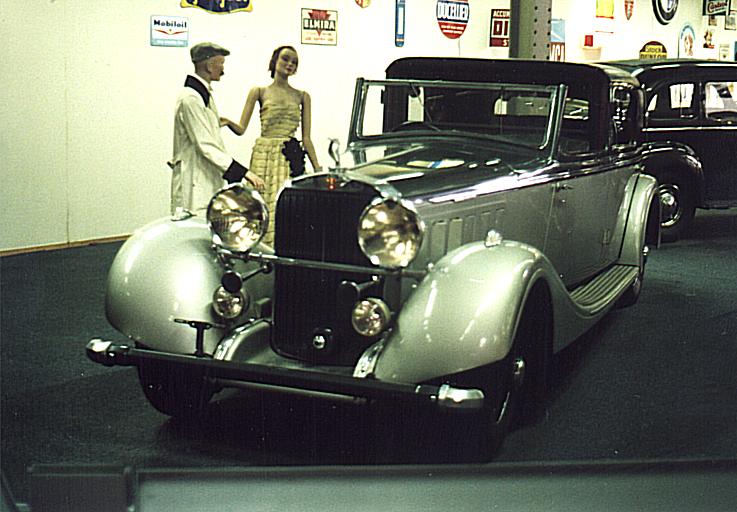Description
The Hispano-Suiza K6 30 CV Chapron was one of the most elegant and technically sophisticated luxury cars of the mid-1930s, representing the refined union of Hispano-Suiza’s advanced engineering and the impeccable craftsmanship of the French coachbuilder Henri Chapron. Built upon the superb K6 chassis, the 30 CV Chapron embodied everything that defined Hispano-Suiza’s reputation in the prewar era—mechanical perfection, silent power, and dignified beauty shaped by the hands of true artisans.
Introduced in 1934, the Hispano-Suiza K6 succeeded the legendary H6 series and served as a more accessible companion to the mighty J12 V12. While smaller in scale, it retained the marque’s unwavering commitment to excellence. The designation “30 CV” referred to its French fiscal horsepower rating, but beneath that understated classification was a 5.2-litre straight-six engine with a single overhead camshaft—an exquisite piece of engineering derived from Marc Birkigt’s aeronautical expertise. The unit produced around 120 horsepower, propelling the car to speeds approaching 140 km/h (87 mph), a remarkable figure for a large luxury car of its time.
The K6’s engine was built to the same meticulous standards as the J12’s V12, with beautifully balanced internals and a silky-smooth delivery of power. It was coupled to a precise four-speed manual gearbox that shifted with the mechanical clarity of a fine instrument. Hispano-Suiza’s patented servo-assisted braking system provided outstanding stopping power, and the independent front suspension ensured a ride of exceptional comfort and composure. The car’s overall refinement and serenity in motion made it one of the finest touring automobiles of the decade.
Henri Chapron, whose coachbuilding atelier in Levallois-Perret was among the most respected in France, gave the K6 a body that matched its mechanical grace. Chapron’s style was distinguished by its restrained elegance, perfect proportions, and fluid lines that combined modernity with classic harmony. The 30 CV Chapron models were typically executed as sedans, coupés, or cabriolets, each tailored to the wishes of the original owner. Every curve and panel was hand-shaped from steel or aluminum, and the coachwork was finished with impeccable precision. The result was a car that exuded quiet authority—sophisticated without being ostentatious.
The front of the K6 Chapron featured Hispano-Suiza’s signature tall radiator with its stork emblem—a nod to the company’s aviation heritage—flanked by elegantly integrated headlamps and sweeping fenders that hinted at motion even when the car stood still. The long bonnet and low roofline gave the car a sense of balance and poise, while the subtle chrome detailing added refinement without excess. Chapron’s mastery lay in his ability to achieve beauty through proportion rather than ornamentation, and this was evident in every inch of the K6’s design.
The interior of the 30 CV Chapron was a triumph of bespoke craftsmanship. Passengers were enveloped in an atmosphere of understated luxury, surrounded by fine leathers, rich wood veneers, and carefully fitted carpeting. The dashboard was simple yet elegant, with clearly arranged instruments and controls that operated with mechanical precision. Many examples were built to chauffeur-driven specifications, with a partition separating the driver from the rear compartment, but even owner-driven cars reflected the same attention to comfort and refinement.
Driving the K6 Chapron was an experience defined by ease and serenity. The inline-six engine delivered abundant torque, allowing the car to accelerate smoothly without effort. The servo-assisted brakes inspired confidence, while the suspension absorbed road imperfections with grace. The steering, though substantial, was precise and well balanced. On open roads, the car cruised with an almost uncanny silence—a hallmark of Hispano-Suiza engineering—and every mechanical component functioned with the exactitude of a fine Swiss watch.
Only a limited number of K6 chassis were ever built, and those bodied by Henri Chapron were among the most coveted. Each was a one-off creation, crafted for an individual of taste and means. The combination of Hispano-Suiza’s precision engineering and Chapron’s aesthetic refinement produced an automobile of timeless quality, admired not for flamboyance but for its quiet confidence and elegance.
Today, the Hispano-Suiza K6 30 CV Chapron is celebrated as one of the most perfectly balanced grand tourers of the interwar period. It embodies the golden age of bespoke French motoring, when craftsmanship, technology, and artistry were fused into a single creation. The car stands as a lasting testament to Hispano-Suiza’s dedication to mechanical perfection and Chapron’s unrivaled sense of proportion—an enduring masterpiece from an era when automobiles were built to be as beautiful as they were extraordinary.
